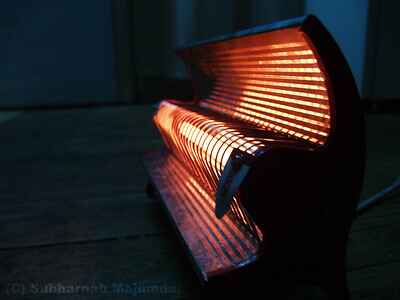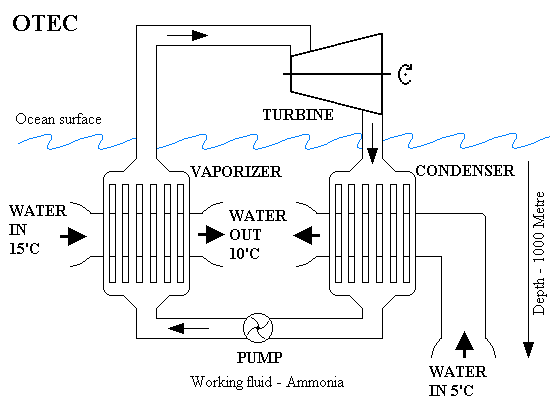5 Sources of Infrared Radiation and Characteristics Explained
Sources of infrared radiation are; fire, solar radiation, organic metabolism, planetary bodies, and artificial heating devices. This article discusses the sources of infrared radiation and their characteristics, as follows;
1). Solar Radiation (as one of the Sources of Infrared Radiation)
A significant portion of solar radiation is infrared. Because solar energy is itself a primary source of renewable energy to the Earth's ecosystems, it can be argued that solar infrared in also a primary form of infrared radiation, and that solar radiation is a primary source of infrared waves on Earth.
Solar radiation contains infrared alongside other electromagnetic waves like ultraviolet rays, radio waves and microwaves [2].
Basically, solar infrared is the portion of solar radiation that has wavelength between 700 nm and 1 mm [3]. It is close to visible light in the electromagnetic spectrum, but is not visible to the human eyes, and can be felt as thermal energy that is absorbed by objects in its path of propagation.
Between 40 and 49% of total solar radiation that reaches the surface of the Earth is infrared, although some studies resolve this range to an average value of about 45%.
On the Earth's surface, infrared occurs as heat that is absorbed, reflected and 'scattered' by surfaces with which it comes in contact, depending on the molecular and geometric attributes of these surfaces.
It is essential for its role in global warming, and its occurrence as thermal-stored energy in renewable energy resources (renewable fuels) like biomass, which are produced ultimately from solar energy.
Solar radiation is the natural source of far-infrared (FIR) that is used in dermal infrared therapy.
2). Organic Metabolism
The body produces infrared radiation in the form of invisible radiant heat, mostly as a result of metabolic activities of living organisms.
Metabolic production of infrared radiation is most prominent in warm-blooded organisms. This includes cellular processes like the breakdown of ATP, in all sizes of organisms including rodents like mice [7].
The emission of infrared waves from organic metabolism is one of the body's self-regulatory processes, which occurs as blood transfers excess heat from one part of the body to another, and from the skin to the external environment, through forced-convective heat transfer that is aided by cardiovascular pumping.
Metabolic infrared can be used in thermal imaging to monitor the activities of living cells in real-time, as part of research or diagnostic procedure [9].
Also, infrared radiation can be deliberately projected onto living cells to increase metabolism and enhance the efficiency of processes like blood circulation [8].
Evidence of infrared from organic metabolism can be seen in thermographic images, which highlight significant amounts of IR emitted from the bodies of organisms.
3). Fire (as one of the Sources of Infrared Radiation)
Infrared light can be derived from fire, mostly as a result of the release of stored bioenergy through combustion.
The amount of infrared heat emitted by fire may vary significantly with conditional factors, although studies have shown that fire can emit infrared with energy intensities of up to 6 W m−2 sr−1/cm−1 [5].
Asides infrared heat, fire also emits red light, which occurs mostly because of a high emission of visible light along the lower frequency end (red, orange) of the ROYGBIV light spectrum. This end is also the one closest to infrared frequency on the electromagnetic spectrum.
Because fire is emitted during the combustion of materials like biomass, infrared from fire is often a secondary form of solar infrared, which has been embedded into organic materials through chemical-energy storage, by biochemical processes like photosynthesis.
Infrared radiation from fire is useful for preventing hazards related to combustion and fire outbreak.
Many fire-detection technologies are centered around the detection of infrared radiation that is emitted by fire. These methods and technologies have found relevance in forest-fire control, among other applications [4].

(Credit: Advanced Spaceborne Thermal Emission and Reflection Radiometer (ASTER) 2003)
4). Planetary Bodies
Infrared waves constitute a major portion of background radiation in space.
Sources of infrared in space include planetary and celestial bodies like asteroids, stars (like the Sun) and planets.
Planets give off infrared from their surfaces as part of stored, absorbed, and reflected electromagnetic radiation.
The primary sources of infrared in outer space are arguably stars, which produce immense amounts of radiation as a result of nuclear fusion reactions occurring between hydrogen isotopes that make up the mass of these stars.
Planets which come in contact with IR from the stars, may absorb significant amounts of this radiation and acquire their own heat. Also, internal processes occurring in the structural layers of these planets can contribute to the production and emission of infrared radiation.
Infrared emissions from planetary bodies are used in the practice of infrared astronomy; whereby thermal imaging techniques are used to study extraterrestrial features and phenomena, to reveal important details not observable using conventional techniques [6].
5). Artificial Heating Devices (as one of the Sources of Infrared Radiation)
Artificial sources of infrared radiation include heaters and lamps powered by electricity, and operated using incandescent technology and other heat-generating mechanisms.
Electric heaters for space, water heating and cooking are capable of emitting significant amounts of high-energy-intensity infrared radiation, with temperatures of up to 1100–2200 °C [1].
The exact manner and intensity of infrared emissions by heating devices is dependent on design, components, specific use, and power consumption rate, among others.

Conclusion
Sources of infrared radiation are;
1. Solar Radiation
2. Organic Metabolism
3. Fire
4. Planetary Bodies
5. Artificial Heating Devices
References
1). Aboud, S. A.; Altemimi, A. B.; Al-HiIphy, A.; Yi-Chen, L.; Cacciola, F. (2019). "A Comprehensive Review on Infrared Heating Applications in Food Processing." Molecules. 2019 Nov 15;24(22):4125. Available at: https://doi.org/10.3390/molecules24224125. (Accessed 4 April 2023).
2). Agrawal, D. C. (2009). "Solar constant versus the electromagnetic spectrum." Available at: https://www.researchgate.net/publication/41890821_Solar_constant_versus_the_electromagnetic_spectrum. (Accessed 4 April 2023).
3). Austin, E.; Geisler, A. N.; Nguyen, J.; Kohli, I.; Hamzavi, I.; Lim, H. W.; Jagdeo, J. (2021). "Visible light. Part I: Properties and cutaneous effects of visible light." J Am Acad Dermatol. 2021 May;84(5):1219-1231. Available at: https://doi.org/10.1016/j.jaad.2021.02.048. (Accessed 4 April 2023).
4). Bordbar, H.; Alinejad, F.; Conley, K.; Hosrikka, S. (2022). "Flame detection by heat from the infrared spectrum: Optimization and sensitivity analysis." Fire Safety Journal 133(7):103673. Available at: https://doi.org/10.1016/j.firesaf.2022.103673. (Accessed 4 April 2023).
5). Parent, G.; Zoubir, A.; Lechêne, S.; Boulet, P. (2010). "Measurement of infrared radiation emitted by the flame of a vegetation fire." International Journal of Thermal Sciences 49(3):555–562. Available at: https://doi.org/10.1016/j.ijthermalsci.2009.08.006. (Accessed 4 April 2023).
6). Rowan-Robinson, M. (2022). "Why do astronomers observe the Universe in infrared?" Available at: https://www.skyatnightmagazine.com/space-science/infrared-astronomy/. (Accessed 4 April 2023).
7). Shi, L.; Liu, X.; Shi, L.; Stinson, H. T.; Rowlette, J.; Kahl, L. J.; Evans, C. R.; Zheng, C.; Dietrich, L. E. P.; Min, W. (2020). "Mid-infrared metabolic imaging with vibrational probes." Nat Methods. 2020 Aug;17(8):844-851. Available at: https://doi.org/10.1038/s41592-020-0883-z. (Accessed 4 April 2023).
8). Tsai, S. R.; Hamblin, M. R. (2017). "Biological effects and medical applications of infrared radiation." J Photochem Photobiol B. 2017 May;170:197-207. Available at: https://doi.org/10.1016/j.jphotobiol.2017.04.014. (Accessed 4 April 2023).
9). Vannocci, T.; Quaroni, L.; de Riso, A.; Milordini, G.; Wolna, M.; Cinque, G.; Pastore, A. (2021). "Label-Free, Real-Time Measurement of Metabolism of Adherent and Suspended Single Cells by In-Cell Fourier Transform Infrared Microspectroscopy." Int J Mol Sci. 2021 Oct 4;22(19):10742. Available at: https://doi.org/10.3390/ijms221910742. (Accessed 4 April 2023).





